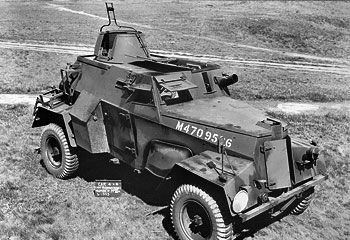Manufacturer Humber (Rootes Group) Weight 3.17 tons Width 6 ft 2 in (1.88 m) | No. built more than 2,400 Length 14 ft 4 in (4.37 m) Height 6 ft 11 in (2.11 m) | |
 | ||
The Humber Light Reconnaissance Car, also known as Humberette or Ironside, was a British armoured car produced during the Second World War.
Produced by the Rootes Group, the Humber Light Reconnaissance Car was an armoured car based on the Humber Super Snipe chassis (as was the 4x4 Humber Heavy Utility car). It was equipped with a No. 19 radio set. From 1940 to 1943 over 3600 units were built.
The vehicle was used by Infantry Reconnaissance Regiments and the RAF Regiment in Tunisia, Italy and Western Europe. After the war, some vehicles remained in service with the British units in India and in the Far East. The LRC was used widely by the Reconnaissance Corps and was also used by the Reconnaissance squadron of the 1st Czechoslovak Independent Armoured Brigade Group.
Three Mk I vehicles were modified for use by the British Royal Family and the Cabinet ministers and were known as Special Ironside Saloons.
Variants
The original version with open-topped hull and 4×2 drive. Armoured to a maximum of 10 mm on the front and 7–9 mm on the sides. Armament was a Boys anti-tank rifle and a Bren light machine gun. Only a limited number were built before the Mk I was replaced by the Mk II.
The Mk II had an enclosed roof with a turret for the machine gun and retained the 4×2 drive of the Mk I. The Boys faced forward in the front of the hull. Otherwise armoured as the Mark I, the roof was 7 mm and the turret 6 mm.
The Mk III was externally similar to the Mk II but had 4×4 drive. Production began in late 1941.
The only difference from the Mk III was additional vision ports at the front angles of the hull. Armour was 12 mm to the front, 8 mm to the sides, 7 on the roof and rear, and 6 mm on the turret.
Built for VIP use, the body by Thrupp & Maberly included a relatively luxurious interior which was split by a Perspex screen to separate driver and passengers. A passenger side door was provided to make entrance and exit easier, the two-part screen running in tracks fitted to the front seats: sliding both portions to the driver's (right) side allowed the front passenger (left) seat back to be folded for an easier exit. Two Ironside 'specials' of this kind were used by cabinet ministers and members of the royal family, while six minus the privacy screen were used as armoured staff cars.
In all 3,600 Humber Light Reconnaissance Cars were built (including the 200 Ironside Is) and the MkIII and MkIIIA were the cars most widely used by the Reconnaissance Corps in action, and many were also employed overseas by the RAF Regiment for airfield defence.
A number of vehicles are preserved in museums:
A reproduction also exists in private ownership in the Czech Republic
